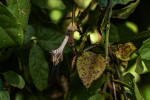Ceropegia arenarioides
Selected images: Click on each image to see a larger version and details of the record View all images (8)
Detailed records: Display species records QDS maps by: Google Maps Point records by Google Maps
Species details: Click on each item to see an explanation of that item (Note: opens a new window)
| Synonyms: | |
| Common names: | |
| Frequency: | |
| Status: | Native |
| Description: |
Perennial climber with semisucculent, hairless, twining stems. Leaves somewhat fleshy, ovate, up to 42 mm long, hairless on both surfaces; margin serrulate/denticulate; petiole c. 8 mm long, hairless. Inflorescence extra-axillary, few-flowered, flowers opening in succession; ; peduncle up to 30 mm long; pedicel c. 6 mm long, hairless. Sepals subulate to linear-lanceolate, c.4.5 mm long, hairless. Corolla 49–55 mm long, slightly curved; tube 28–34 mm long, basal chamber double, lower ovoid, 8–8.5 mm long and 3.8–5.5 mm wide, then abruptly expanded into a second subglobose inflation 4.2–6.2 mm wide, gradually narrowed at apex, limb cylindrical, 2.4–3.1 mm wide, widening abruptly to 10–13 mm at mouth, exterior pale cream uniformly covered with purple spots, hairless; sinuses rounded, spreading and gaping; lobes triangular-attenuate, c. 21 mm long, apices converging to form a narrowly conical cage, hairless outside but shortly hairy on the margin, inside white for more than half length, tip dark purplish brown, sparsely stiffly hairy. Follicles and seed not recorded. |
| Type location: |
Zimbabwe |
| Notes: | This species may be more common and widespread than known records suggest due to long term confusion with Ceropegia nilotica. Both species are very similar vegetatively but clearly differ in the flowers of C. arenarioides bearing much longer corolla lobes which extend into a slender, acuminately tapered beak. |
| Derivation of specific name: | |
| Habitat: | Among bushes in Acacia and mopane bushveld, on reddish soil and hard brown loam. |
| Altitude range: (metres) | 300 - 1200 m |
| Flowering time: | |
| Worldwide distribution: | Mozambique, Zambia, Zimbabwe, Botswana and Namibia. |
| FZ divisions: | N,T,MS |
| Growth form(s): | |
| Endemic status: | |
| Red data list status: | |
| Insects associated with this species: | |
| Spot characters: | Display spot characters for this species |
| Images last updated: | Tuesday 6 July 2021 |
| Literature: |
Goyder, D.J., Gilbert, M.G. & Venter, H.J.T. (2020). Apocynaceae (Part 2) Flora Zambesiaca 7(2) Pages 147 - 148. Protologue (Includes a picture). |
Other sources of information about Ceropegia arenarioides:
Our websites:
Flora of Botswana: Ceropegia arenarioidesFlora of Caprivi: Ceropegia arenarioides
Flora of Zambia: Ceropegia arenarioides
Flora of Zimbabwe: Ceropegia arenarioides
External websites:
African Plants: A Photo Guide (Senckenberg): Ceropegia arenarioidesAfrican Plant Database: Ceropegia arenarioides
BHL (Biodiversity Heritage Library): Ceropegia arenarioides
EOL (Encyclopedia of Life): Ceropegia arenarioides
GBIF (Global Biodiversity Information Facility): Ceropegia arenarioides
Google: Web - Images - Scholar
iNaturalist: Ceropegia arenarioides
IPNI (International Plant Names Index): Ceropegia arenarioides
JSTOR Plant Science: Ceropegia arenarioides
Mansfeld World Database of Agricultural and Horticultural Crops: Ceropegia arenarioides
Plants of the World Online: Ceropegia arenarioides
Tropicos: Ceropegia arenarioides
Wikipedia: Ceropegia arenarioides



